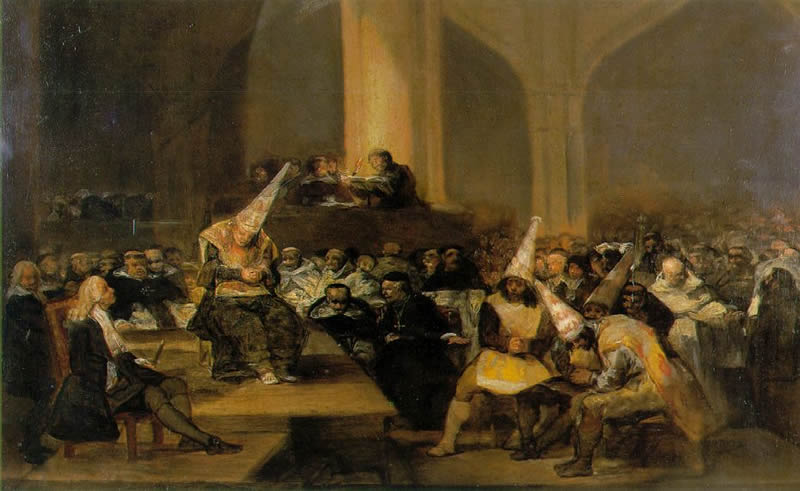Can beauty or aesthetic pleasure portray the inhumanities of man? The answer is, of course, yes— Guernica, by Picasso. But can art go further? Can she be political and still maintain her cloak of beauty besmirched by the muck of caricature or cartoon? More to the point, is it possible to paint Rumsfeld up to his knees in sand and innocent Arab blood in a patriotic act and still make a beautiful painting? After all, Cheney jerking off to a brave man crumbling under the inhuman technique of water boarding is not the subject matter of great art…unless you are Goya.
In Judicial Session Of The Inquisition, Goya paints reality, not caricature, and he paints it beautifully with naked emotion in golds, reds and black. The smugness of the jury and the agonies of the convicted are all too evident in the cavernous room that fades into hopeless stretches of black, which are illuminated only by the bravery of the artist to do such a thing right in the face of the church.
Goya’s etchings are works of art deeply involved in the depravity of mankind to the point of depressing the viewer into hopelessness were it not for the fact that they are so moving. They are about truth and not entertainment, whose job is to avoid reality. They do not make light of a serious subject the way our late night TV host does, making us laugh about things we ought be insulted and enraged by.
Abu Graib has put us on the same page as the inquisition, where the innocent are tortured into useless confessions for the protection of the nation instead of the church. So you may ask, where is our Goya to redeem us? Not all our artists are hiding in universities behind theory or obsessing over the sexual torture of S&M. However most conceptual artists do not realize that making something ugly about something ugly only increases the horror. Leon Golub makes paintings about torture but they are garishly depicted without beauty and in drab colors making them heavy-handed and therefore manipulative. Without the balancing act of beauty, his subject matter tumbles into propaganda. When Goya combines the same depressing subject matter with aesthetic pleasure, the result is a breathtaking tightrope act, the painting becomes human with soaring flights of sadness and bottomless pits of truth.
Goya was also one of the few to paint actual human expressions of fear, agony, and anger but not one of the last. In Marlene Dumas’s portraits only the dead have calm faces, the rest are terribly human. The haunting portrait of a bag over someone’s head is both beautifully painted and immediately recognizable as the bag we put over the prisoner’s head. It is also reminiscent of the dehumanizing cone hats painted by Goya, which the inquisition forced its accused to wear.
When beauty puts her arms around the baseness of man and holds it to her breast, the monstrosities we are capable of, then come out of the shadows of silence, where they have so much power to frighten us. Beauty can lead these monsters into the light. No amount of words and logic can explain away ethnic culling, but the elegance of ritual whispers to the unconscious, visual satisfaction releases a frightened flock of unnamed emotions, and we begin to feel. It’s only when looking at a field of flowers, that you forgive nature her barbaric cruelties. We watch the moon crossing the starry night with the same hunger that we stare at a Goya.
Artillery Magazine Vol 3 no. 2 November/December 2008
